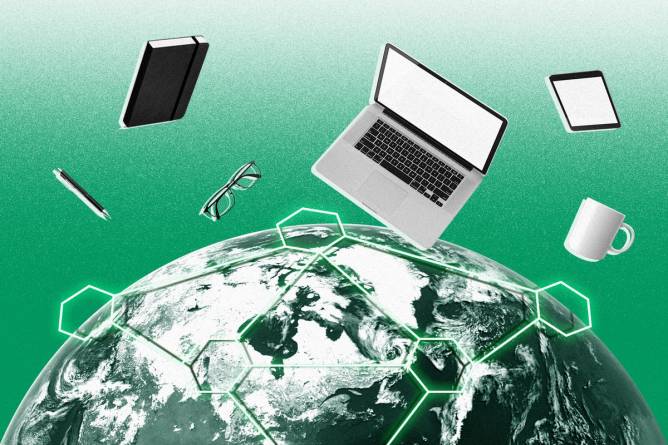|
Happy Monday! We’re sorry to report that the weekend is over, but at least you’ve got a fresh HR Brew to start your week. And hopefully you’ve got some fresh brew, too!
In today’s edition:
 Communication is key Communication is key
 Didn’t see that coming Didn’t see that coming
 World of HR World of HR
—Paige McGlauflin, Kristen Parisi
|
|
J Studios/Getty Images
|
Ask any marriage therapist: communication is key. And this doesn’t just apply to George coming clean to Martha about what really happened at last year’s endodontist conference in Pasadena—it goes for companies and their employees, too.
Internal communication is an important factor in securing high employee engagement and retention. When leveraged well, it’s a powerful tool for helping employees feel in tune with their company, improving cross-team collaboration, and boosting worker satisfaction, prior research has found. That said, some companies are doing a poor job at employee comms, a new study from USC Annenberg and Staffbase, an employee communications platform, suggests.
Comms oversight. The research, based on 20 interviews with chief communications officers at large companies including Levi’s, ExxonMobil, and IBM, as well as a survey of more than 1,000 workers at large companies, found that just 29% of workers are very satisfied with their employer’s quality of employee communications. Workers who felt they received enough information from their employer were more likely to report being happy with their job, and very likely to stay at their company than respondents who were not satisfied with their company’s comms practices, according to the report.
Areas for improvement. Wolf shared two suggestions that HR leaders can consider for improving their own internal communications approaches.
Keep reading here.—PM
|
|
|
It’s important to know what’s working and what isn’t in your company culture—for the sake of your employees and your bottom line.
You can start with BambooHR’s new e-book, The Top 10 Signs of Bad Company Culture. It lists workplace red flags to look for and strategies to address the issues.
You’ll also find employee retention strategies, tips for creating an all-around great place to work, and more.
No matter what color flags you’re seeing in your organization, it’s helpful to be aware of these common issues and how to prevent them from impacting your workplace.
Download the e-book.
|
|
Francis Scialabba
|
Following a slew of worrying labor market data published earlier this summer, today’s jobs report from the Bureau of Labor Statistics is like a breath of fresh air.
US employers added 254,000 jobs in September, a 95,000 increase from August, marking the largest month-over-month jump since last December when 108,000 more jobs were added. Companies also added more jobs than initially reported in July and August, revising the numbers to 144,000 and 159,000 respectively. The unemployment rate fell to 4.1% last month from 4.2% in August.
A September surge? Employers, particularly those that need to bulk up their workforces for the holiday season, tend to start ramping up hiring in the autumn. It’s a phenomenon known as the “September surge.” But the spike in hiring could also be attributed to employers in white collar industries overcorrecting for layoffs earlier this year, Kate Duchene, CEO of consulting firm RGP, told HR Brew.
Zoom out. September’s surprisingly strong numbers also came ahead of the anticipated business impacts from the US Federal Reserve Bank’s interest rate cuts in mid-September. According to a recent pulse survey from RGP of 204 financial decision-makers at large companies, nearly two-thirds (62%) expect increased investment from the rate cuts to start permeating through their organizations later in 2024, or in the first half of 2025. As such, companies will likely start hiring soon as part of these unlocked business investments.
Keep reading here.—PM
|
|
Francis Scialabba
|
Men in the UK want better access to paternity leave, and they’re letting the world know by adorning bronze statues with baby dolls in slings.
Where in the world? The Dad Shift, a parental leave advocacy group, put baby dolls on famous statues throughout London and Edinburgh, including those depicting Singing in the Rain actor Gene Kelly and soccer star Thierry Henry, NPR reported, in an effort to raise awareness of the lack of paternity leave in the UK. The group wants fathers to be paid an adequate salary and enough time off, so they can afford to be home with their new children.
The UK has among the most paltry paternity leave policies in Europe. While men have a right to paternity leave, they are only guaranteed two weeks and receive just £184.03 a week when they’re off. As a result, nearly one in five fathers don’t take any time off compared to new moms, who take around 40 weeks of leave, according to research from Trades Union Congress done in 2023. Comparatively, men in some other European countries, such as Spain and Finland, get at least 16 weeks off at their full pay.
Satellite view. The US does not guarantee any paid parental leave, regardless of gender. Workers prefer companies that provide leave, and while just 13% of men work at companies with paternity leave, according to the National Partnership for Women & Families, some research indicates that access to paternity leave in the US is expanding.
Keep reading here.—KP
|
|
The L&D MVP. Looking for leadership and development programs that can build your team’s business and people skills? Abilitie’s AI Cases empower learners to tackle realistic and universal leadership challenges through practice with AI-enabled characters. Intrigued? Register for a live session on Oct. 10 to experience this scalable program. |
|
Francis Scialabba
Today’s top HR reads.
Stat: Half of US workers report having experienced a mental health issue over the last year. (BusinessSolver)
Quote: “Employers who rely on monitoring are sending the message they don’t trust their employees. If you don’t trust your employees, you haven’t done a good job hiring.”—Bryan Driscoll, an HR consultant, on how employee monitoring can erode trust between companies and workers (Newsweek)
Read: Wisconsin, Pennsylvania, and Idaho are among the states that provide tax credits to companies that help their employees save for college. (the New York Times)
Watch out for these: When was the last time you checked your company culture for red flags? This is your sign to do it. It’s easy with BambooHR’s new e-book. Check it out.* *A message from our sponsor.
|
|
Level up your career with these resources from our sponsors!
|
|
|
Share HR Brew with your coworkers, acquire free Brew swag, and then make new friends as a result of your fresh Brew swag.
We’re saying we’ll give you free stuff and more friends if you share a link. One link.

Your referral count: 2
Click to Share
Or copy & paste your referral link to others:
hr-brew.com/r/?kid=9ec4d467
|
|
ADVERTISE
//
CAREERS
//
SHOP
//
FAQ
Update your email preferences or unsubscribe
.
View our privacy policy
.
Copyright ©
2024
Morning Brew. All rights reserved.
22 W 19th St, 4th Floor, New York, NY 10011
|
|










